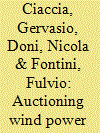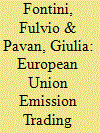| Srl | Item |
| 1 |
ID:
094842


|
|
|
|
|
| Publication |
2010.
|
| Summary/Abstract |
In this work, we propose an index that allows a public authority to order different projects for the construction of onshore wind energy plants and that explicitly takes into account their environmental quality. Wind farm projects are defined as vectors of four attributes: the technical properties of each project, its social impact, its environmental impact, and the share of earnings that proponents offer to the collectivity in compensation for the negative externalities of the wind plant. We define an absolute index that allows the ordering of different proposals and evaluation of the acceptability of each project, providing the monetary value of each point and inducing a truthful revelation of firms' private information. Moreover, we calibrate the index on the basis of data referring to wind plants in Southern Italy and derive the corresponding iso-scoring curves.
|
|
|
|
|
|
|
|
|
|
|
|
|
|
|
|
| 2 |
ID:
133312


|
|
|
|
|
| Publication |
2014.
|
| Summary/Abstract |
We evaluate the contribution of technological change in reducing CO2 emissions in the Italian pulp and paper industry during the first and second phases of application of the European Union Emission Trading System (EU-ETS). We decompose the variation in emission and emission intensity into three different types of effects: a composition effect, a technique effect and a scale effect. The composition effect measures the change in emissions and emissions intensity due to a shift in production towards products that cause less emissions. The technique effect measures the change per each type of product, thereby accounting for technology improvements in the production of each type of good produced. The scale effect singles out the reduction in total emission due to an overall reduction in output. We show that the first phase of the application of EU-ETS has led to a reduction in both emissions and emission intensity due to the composition effect. The technological change has had a limited negative impact on emissions in the first phase, while in the second phase there has been limited technology improvement in the industry. However, the figures of the scale effect show that the larger reduction in emission is due to the overall decrease in output.
|
|
|
|
|
|
|
|
|
|
|
|
|
|
|
|